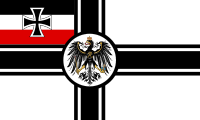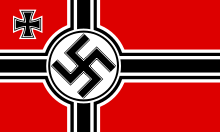Reichskriegsflagge
Reichskriegsflagge (Imperial War Flag) was the official name of the war flag used by the German armed forces from 1867 to 1945. A total of seven different designs were used during this period.
Imperial Germany


The German war flag was in common use in World War I. It had Prussia's national colours of black and white, the eagle of Prussia, the Nordic cross, with the German imperial black-white red tricolour in the upper canton with an Iron Cross. In 1919, the flags of Imperial Germany were scrapped and replaced by those of the Weimar Republic: black-red-gold tricolour.
German nationalists, such as the Freikorps (see Marinebrigade Ehrhardt) and later the Nazis, used the old flag in protest against the Weimar Republic during the 1920s and 1930s. This included the 1920 attempt to overthrow the Weimar government, known as the Kapp Putsch.[2]
Use during the Third Reich, 1933-45
Designed personally by Adolf Hitler, this flag served the Heer and the Luftwaffe as their War Flag, and the Kriegsmarine as its War Ensign (the National Flag serving as Jack). This flag was hoisted daily in barracks operated by units of the Wehrmacht, and it had to be flown from a pole positioned near the barracks entrance, or failing this, near the guard room or staff building. New recruits in the latter part of World War II were sworn in on this flag (one recruit holding the flag and taking the oath on behalf of the entire recruit class with the recruits looking on as witnesses - before, this was done on the regimental colors).

The flag had to be formally hoisted every morning and lowered every evening. These hoisting and lowering ceremonies took the form of either an ordinary or a ceremonial flag parade. At the ordinary raising, the party consisted of the Orderly Officer of the Day, the guard, and one musician. At the ceremonial raising, one officer, one platoon of soldiers with rifles, the guard, the regimental band, and the corps of drums were all present.
The proportions of the flag are 3:5. Fusing elements of the Nazi German Flag (swastika and red background) with that of the old Imperial Reich War Flag (four arms emanating from off-center circle and Iron Cross in the canton), these flags were uniformly produced as a printed design on bunting.
Raised for the first time at the Bendlerstraße Building (Wehrmacht Headquarters) in Berlin on November 7, 1935, It was taken down for the last time by British occupation forces after the arrest of the Dönitz Government at Flensburg's Mürwik Naval School, Germany, on May 23, 1945.
In his book, Inside the Third Reich, Albert Speer states that "in only two other designs did he (Adolf Hitler) execute the same care as he did his Obersalzberg house: that of the Reich War Flag and his own standard of Chief of State."
Use after 1945

Outside of educational, artistic or scientific contexts, selling and showing symbols of Nazi Germany, including the Reichskriegsflagge, is illegal in Germany according to Strafgesetzbuch section 86a. This covers the version used after 1935 with the swastika.
The original flag used between 1871 and 1919 can be shown depending on circumstances in different states of Germany. Because members of the far right have used the imperial war flag as a symbol, its use is considered to be a "breach of the public order" in seven states, and flags will be confiscated. In the other nine states, any provocative misuse of the flag can be prosecuted as an Ordnungswidrigkeit (summary offence).
Kriegsflagge
-

North German Federal Navy 1867–71 and Kaiserliche Marine War Ensign 1871–92 (Reichskriegsflagge)
-

Kaiserliche Marine War Ensign 1892–1903
-

Kaiserliche Marine War Ensign 1903–19
-
.svg.png)
1919–21 War ensign (de facto never used)
-
.svg.png)
1921–33 War ensign
-

1933–35 War ensign
-

1935–38 War ensign
-

1938–45 War ensign
See also
- Blutfahne
- Flag of Nazi Germany
- Flag of Germany
- Führerstandarte
References
- Davis, Brian Leigh, and Malcolm McGregor (2000). Flags of the Third Reich. Oxford, England: Osprey Publishing Company. ISBN 1-84176-171-0.
Notes
- ↑ 1.0 1.1 Click picture for German Federal Archive record
- ↑ See Kapp Putsch pictures and notes from the German Federal Archive
External links
| Wikimedia Commons has media related to Reichskriegsflagge. |